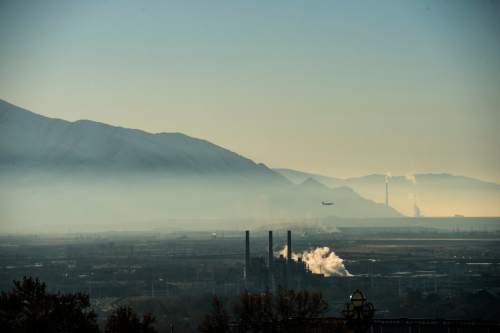This is an archived article that was published on sltrib.com in 2016, and information in the article may be outdated. It is provided only for personal research purposes and may not be reprinted.
A new study led by the Utah Division of Air Quality aims to determine whether minute amounts of certain toxic chemicals make particulate pollution along the Wasatch Front even more harmful than normal.
Environmental scientists from the Division of Air Quality (DAQ) and chemists from Brigham Young University plan to spend the next two years using state-of-the-art technologies to test the air in West Valley City for particularly harmful pollutants known as "air toxics."
These chemicals are considered especially harmful to human health, even in small quantities. Benzene, for example, is associated with blood disorders. Tetrachloroethylene, which is used in dry cleaning, can cause respiratory irritation, kidney dysfunction and even behavioral changes. Most are carcinogens or likely carcinogens.
These chemicals are difficult to detect in the air because they are normally present in much smaller quantities than other pollutants, such as ozone, said Patrick Barickman, who oversees the DAQ's technical analysis section. Air toxics are controlled by federal rules that regulate industrial processes, but because they are so difficult to monitor on a regular basis, the Environmental Protection Agency has no ambient air standards for them as it does for pollutants like ozone or PM 2.5.
Barickman said the DAQ also plans to study the chemical composition of particulate pollution to determine whether these harmful chemicals — many of which potentially contribute to the formation of secondary particulates — are also present in the particles that build during Utah's inversions.
The public often doesn't realize that the actual chemical composition of particulate pollution can vary, as can the health consequences associated with those various particles, Barickman said.
Monitoring concentrations of air toxics in West Valley City will tell the department whether that area exceeds the norm when compared to other urban areas, Barickman said. This study will also evaluate specific subtypes of the chemicals to determine whether they might be coming from, for example, diesel fumes or other industrial pollution.
"It's information for the agency, but it's also information for the public," he said.
"West Valley City is an area where emissions from industry, highways, the airport and winter inversions combine to create exposure concerns for the local community," Shaun McGrath, EPA's Region 8 administrator, said in a statement. "The data generated by this project will be critical to understanding and reducing health impacts form hazardous air pollutants in the area."
West Valley City is also located at one of the valley's lowest points, Barickman said, which suggests that pollutants, including air toxics, may tend to pool in that area.
Utah's Division of Air Quality has studied air toxics in the past, Barickman said, and has a regular monitoring program in Bountiful. This study, funded by a $355,000 grant from the EPA, will give the DAQ insight into air toxics concentrations in another part of the valley, he said, and also take advantage of some cutting-edge technologies to go into greater detail than past studies.
Twitter: @EmaPen



